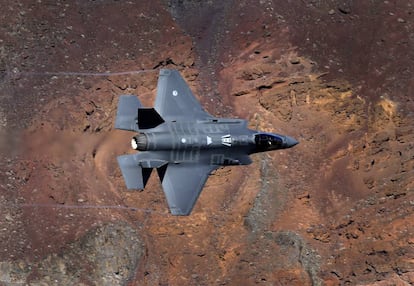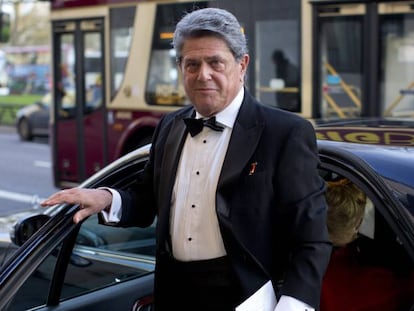Spain’s Air Force and Navy have sights set on new American fighter aircraft
Despite its price tag, officials prefer the F-35 Lightning II to the alternative of more Eurofighters
After investing €10.6 billion on the European fighter plane, it turns out that Spain’s future military aircraft will in all likelihood be American-made. The Spanish Air Force and Navy have their sights set on the F-35 Lightning II joint strike fighter, made by Lockheed Martin, to replace the F-18s and vertical take-off Harriers that will be decommissioned halfway through the next decade.

An estimated 45 to 50 aircraft will be required for the Spanish Air Force and another 12 to 15 for the Navy. The program could represent spending of over €6 billion, and more than double that considering the logistical support required to keep the aircraft operational.
There is no alternative for the Navy, if it wants to maintain its naval aviation capacity – the ability to launch air power from a ship. The Navy will have to gradually decommission its remaining AV-8B Harrier II Plus aircraft, and the only planes available on the market capable of Vertical/Short Take Off and Landing (V/STOL) are the F-35s. Without them, the Navy’s flagship Juan Carlos I would be reduced to the category of helicopter carrier.
Of the 86 aircraft currently in service, the ones in the Canary Islands are in most urgent need of replacement
Navy officials are aware that the F-35 is too expensive (between €90 and €130 million a unit, not counting the engine) and that their order of 12 to 15 planes would be too small for any meaningful negotiating margin. But things would be different if the Air Force decided to order the same model, said high-ranking Navy officials.
The future fighter aircraft is one of the priorities of the new Armed Forces Capacity Objective slated for approval before the end of this year, said General Fernando Alejandre, the new chief of the defense staff. The goal is to replace the F-18 fighters, which, together with the Eurofighter and the EF2000, are at the forefront of the Spanish Air Force’s aircraft program.
The F-18 allowed the Air Force to make a quantum leap forward in the 1980s in terms of technological capacity, but the fleet is now 30 years old and most aircraft have more than 5,000 hours of flying under their wings, with the limit set at around 7,000. Of the 86 aircraft currently in service, the ones in the Canary Islands are in most urgent need of replacement, as they have around three years of service left. All the F-18’s will need to be phased out starting in 2025.

Although that may sound like a long time, military sources said that the process to acquire a new fighter plane is very long, meaning that a decision should be reached by 2018 at the latest. “The more we wait, the worse negotiating conditions we will have,” said a source.
Air Force sources said that, even with improvements, the Eurofighter cannot compare with the F-35, a fifth-generation fighter that has integrated sensors on the pilot’s helmet, granting 360-degree vision. They also allege that relying on a single model could make the Air Force vulnerable in the event of a structural problem with the Eurofighters.
The EF2000 is a European program that Spain participates in with a 14% stake, and which creates around 3,000 direct jobs in the country. The F-35 is an American aircraft in whose production process Spain would play an insignificant role. The country was asked to join the F-35 consortium back in the day (along with Britain, The Netherlands, Italy, Australia, Canada, Denmark, Norway and Turkey) but the Defense Ministry declined the invitation.
“The financial contribution was very high, and the industrial return small,” said a source who held a position of responsibility over the matter at the time. “We could not afford to pay for the EF2000 and the F-35 at the same time.”
Given its political, industrial and military implications, the purchase of the armed forces’ future aircraft is one of the most important decisions that Defense Minister María Dolores de Cospedal will have to make. That is, of course, as long as the defense budget increases and there is enough money to pay for it.
English version by Susana Urra.
Tu suscripción se está usando en otro dispositivo
¿Quieres añadir otro usuario a tu suscripción?
Si continúas leyendo en este dispositivo, no se podrá leer en el otro.
FlechaTu suscripción se está usando en otro dispositivo y solo puedes acceder a EL PAÍS desde un dispositivo a la vez.
Si quieres compartir tu cuenta, cambia tu suscripción a la modalidad Premium, así podrás añadir otro usuario. Cada uno accederá con su propia cuenta de email, lo que os permitirá personalizar vuestra experiencia en EL PAÍS.
¿Tienes una suscripción de empresa? Accede aquí para contratar más cuentas.
En el caso de no saber quién está usando tu cuenta, te recomendamos cambiar tu contraseña aquí.
Si decides continuar compartiendo tu cuenta, este mensaje se mostrará en tu dispositivo y en el de la otra persona que está usando tu cuenta de forma indefinida, afectando a tu experiencia de lectura. Puedes consultar aquí los términos y condiciones de la suscripción digital.
More information
Archived In
Últimas noticias
Most viewed
- Why we lost the habit of sleeping in two segments and how that changed our sense of time
- Charles Dubouloz, mountaineering star, retires at 36 with a farewell tour inspired by Walter Bonatti
- Venezuela faces its most tense Christmas yet
- CBS in crisis after pulling a report on Trump’s deportations to El Salvador (which later leaked online)
- Bukele clan fumes over investigation exposing their new wealth











































